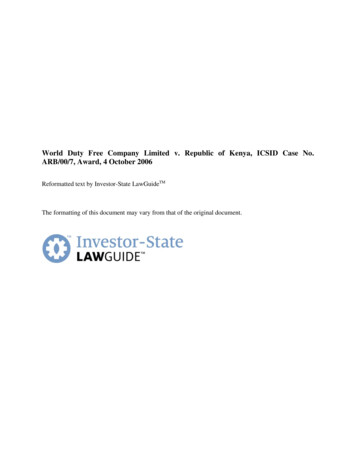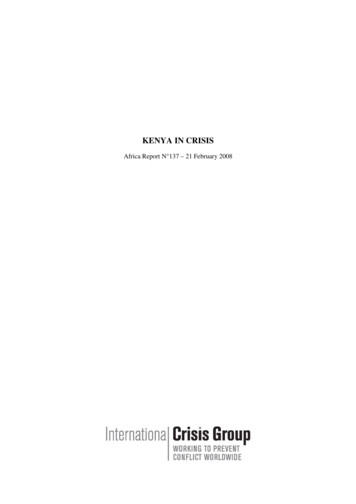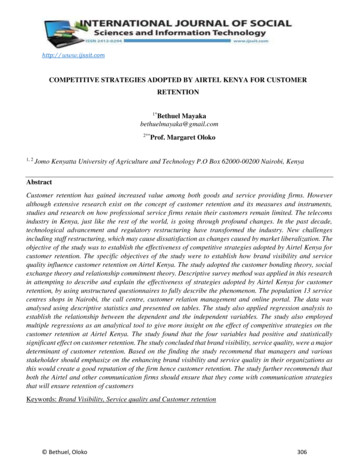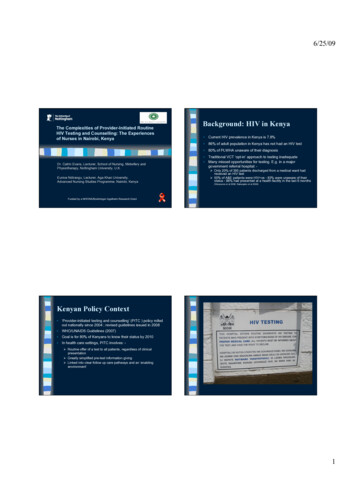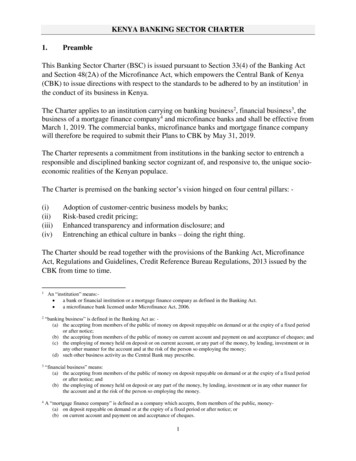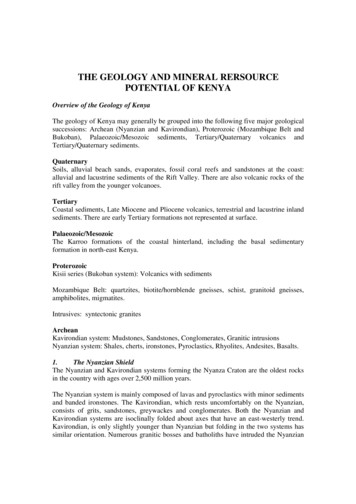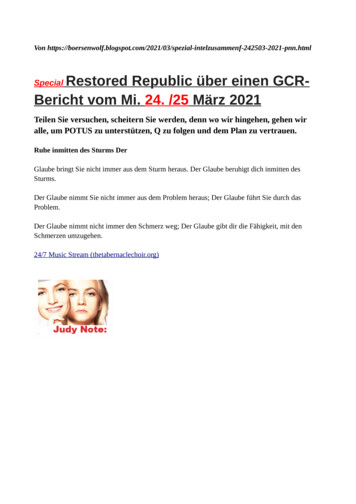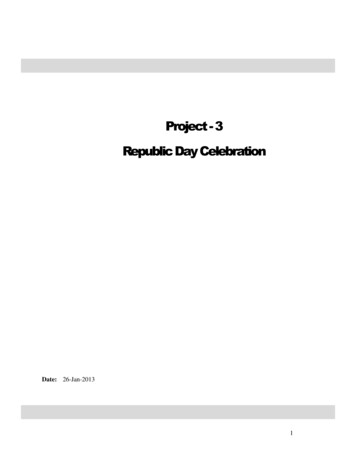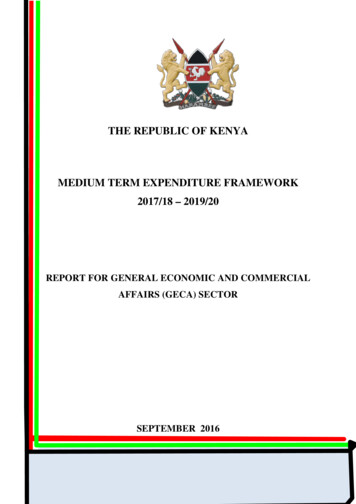
Transcription
THE REPUBLIC OF KENYAMEDIUM TERM EXPENDITURE FRAMEWORK2017/18 – 2019/20REPORT FOR GENERAL ECONOMIC AND COMMERCIALAFFAIRS (GECA) SECTORSEPTEMBER 2016
LIST OF ACRONYMSACAAnti –Counterfeit AgencyACUAIDS Control UnitADBAfrican Development BankAGAsAutonomous Government AgenciesAGOAAfrican Growth and Opportunity ActAIAAppropriation in AidAIDSAcquire Immune Deficiency SyndromeAIEAuthority to Incur ExpenditureASKAgricultural Show of KenyaASALArid and Semi-Arid landsASMEPAssistance to Micro and Small Enterprise ProgrammeBDSBusiness Development ServicesBICsBusiness Information CentresBISBusiness Incubation ServicesBKBBrand Kenya BoardBPOBusiness Process OutsourcingBPRTBusiness Premises Rent TribunalBQBill of QuantityBROPBudget Review and Outlook PaperBSCsBusiness Solution CentresBSPSBusiness Sector Programme SupportCABsConformity Assessment BodiesCAMSComputerized Audit Management SystemCBOsCommunity Based OrganizationsCDACoast Development AuthorityCETCommon External TariffsCIDCConstituency Industrial Development CentresCMFCommon Manufacturing FacilitiesCMPCommon Market ProtocolCNCComputer Numerical ControlledCOMESACommon Market for Eastern and Southern AfricaCSOsCivil Society OrganizationsDANIDADanish International Development AgencyDDADoha Development AgendaDFIDSub-sector for International DevelopmentEACEast African CommunityEACCMAEast African Community Customs Management ActCCOSEthics Commission for Cooperative SocietiesEAMUEast African Monetary UnionEAPCCEast African Portland Cement CompanyECEuropean CommissionEDFEuropean Development FundEOIExpression of InterestEPAEconomic Partnership AgreementEPCExport Promotion CouncilEPZAExport Processing Zones AuthorityEPZExport Processing ZoneESPEconomic Stimulus ProgrammeEUEuropean UnionFDIForeign Direct InvestmentFKEFederation of Kenya EmployersFTAFree Trade AreaGDPGross Domestic ProductGECAGeneral Economic and Commercial AffairsGJLOsGovernance, Justice, Law and OrderGOKGovernment of Kenyai Page
BSJPCKEBSKENASKEN MANEPADNGONIPNITCii P a g eHuman Immunodeficiency VirusIndustrial and Commercial Development CorporationInformation, Communication and TechnologyInternational Development AgencyIndustrial Development BankIntegrated Financial Management Information SystemInter-Governmental Authority on DevelopmentInvestment Programme for the ERSIntellectual Property RightsIndia Ocean Ream AssociationJapan International Cooperation AgencyJomo Kenyatta University of Agriculture and TechnologyJoint Loan Board SchemeJoint Permanent CommissionKenya Bureau of StandardsKenya National Accreditation ServiceKenya Investment AuthorityKenya South Sudan Support ProgrammeKenya South Sudan Liaison OfficeKenya Farmers’ Cooperative UnionKenya Institute of Business TrainingKenyatta International ConventionKenya Industrial EstatesKenya Industrial Property InstituteKenya Industrial Research and Development InstituteWestern Region CentreKisumu Industrial Training CentreKenya Industrial Training InstituteKenya Leather Development CouncilKenya National Trading CorporationKenya Revenue AuthorityKenya Safari Lodges and Hotels limitedKenya Tourist BoardKenya Tourist Development CorporationKenya Textile Training InstituteKenya Utalii CollegeKerioValley Development AuthorityKenya Wine Agencies LimitedLamu Port Southern Sudan Ethiopia TransportLeather Development CentreMonitoring and EvaluationMillennium Development GoalsMeetings, Incentive, Conferences and ExhibitionsMemorandum of UnderstandingMicro and Small EnterprisesMicro and Small Enterprises AuthorityMicro, Small and Medium EnterprisesMicro, Small and Medium IndustriesMedium Term Expenditure FrameworkMedium Term PlanNational Council for Small EnterprisesNational Committee on World Trade OrganizationNational Environmental Management AuthorityNew Partnership for Africa’s DevelopmentNon-Governmental OrganizationNational Industrialization PolicyNational Industrial Training Council
TTFUNDPUNESCOUNFPAUNWTOUSAUSAIDVATW&MWBWTOiii P a g eNew Kenya Cooperative CreameriesNumerical Machining ComplexNational Oil Corporation of KenyaNational Qualification FrameworkNon-Tariff BarriersOperation and MaintenanceOne Village One ProductPerformance Appraisal SystemProgramme Based BudgetingProducer Business GroupsProductivity Centre of KenyaPublic Expenditure ReviewPublic Private PartnershipProgramme Performance ReviewResearch and DevelopmentRegional Development AuthoritiesRegional Economic CommunitiesSavings and Credit Co-operative OrganizationsSouthern Africa Development CorporationSemi-Autonomous Government AgenciesSacco Society Regulatory AuthoritySpecial Economic ZonesSmall and Medium EnterpriseSmall and Medium IndustryTana and Athi River Development AuthorityTourism FundTechnical Vocational Education and TrainingTourism Satellite AccountTourism Trust FundUnited Nations Development ProgrammeUnited Nations Education Social and Cultural OrganizationUnited Nations Population FundUnited Nations World Tourism OrganizationUnited States of AmericaUnited States Agency for International DevelopmentValue Added TaxWeights and MeasuresWorld BankWorld Trade Organization
EXECUTIVE SUMMARYThe General Economic and Commercial Affairs (GECA) MTEF Sector mandate straddlesindustrialization, investment, cooperatives development, trade, regional integration andtourism matters. The Sector is comprised of five Sub-sectors namely: Investment andIndustry, Cooperatives Development, Trade, East African Community Integration andTourism. It is crucial to the Country’s sustainable economic development, job creation andpoverty reduction.The Sector programme formulation is guided by Kenya Vision 2030, the country’s long-termdevelopment blue print which aims to achieve an industrialized, middle income country withhigh quality of life for all citizens by the year 2030. The Sector plays a key role in therealization of the targets of the economic pillar of Vision 2030 as expounded in the SecondMedium Term Plan (MTP II) and the Jubilee Administration’s transformative agenda. It isalso alive to Africa’s aspirations as outlined in the African Agenda 2063 and its first ten yearimplementation plan, the Agenda 2030 on Sustainable Development Goals and the ParisAgreement on Climate Change.The six medium term priorities are promotion of investments, increased manufacturing shareto the GDP and exports, improvement of the business environment, savings mobilization andgood governance in cooperative development, trade development and fair trade practices,promotion of regional integration and sustaining tourism recovery.This Sector report is structured in four main chapters, then conclusions andrecommendations. Chapter one (1) discusses the background to the sector and highlights thevision and mission, goals and objectives, the mandates of the sub-sectors, the SAGAs withinthe sector and Sector stakeholders. The chapter also presents the overall mandate of the sectorwhich is industry and investment promotion, enhancement of the business environment,savings mobilization, trade promotion and development, regional integration and tourismdevelopment.Chapter two (2) presents the achievements of the Sub–Sector during the period 2013/14 –2015/16. The Sector prgrammes/sub-programmes, expected outputs, targets and keyperformance indicators are reviewed in this chapter as well as analysis of expenditure vis avis budget allocation for the review period. During the review period, approved budgetincreased by KShs. 4.05 billion from KShs.13.06 billion in 2013/14 financial year toKsh.17.11 billion in 2015/16 financial year. This is however a marginal increase despite thesectors growing importance, especially its contribution to the attainment of Vision 2030targets.The manufacturing sector accounted for 10 per cent of GDP in 2015 and engaged 2.8 millionpersons in 2015 up from 2.4 million in 2013. During the same period, the country’scompetitiveness as measured by World Bank’s Doing Business global ranking indeximproved by 21 points to 108 according to World Bank Doing Business Report 2016. Thisimplies that there is an improved business environment for both Domestic and foreigninvestments. Total Foreign Direct Investment (FDI) inflow doubled from Ksh.101 Billion in2013/14 to Ksh.224 Billion in 2015/16 while FDI and Domestic Investment at ExportProcessing Zone (EPZ) increased from Ksh.48 billion in 2013/14 to Ksh.67 billion in2015/16. The country’s total exports to AGOA markets rose from Ksh.47 billion to KShs. 67billion during the same period, out of which exports of apparels increased by 14.4 per centfrom Kshs.30.2 billion to Ksh.34.6 billion.During the review period, the Sector initiated review of the Co-operative DevelopmentPolicy and co-operative legislation with a view to conforming to the provisions of theConstitution. Moreover, modernization of New Kenya Co-operative Creameries (New KCC)plant and equipment was kick started leading to increased processing capacity from 110,000to 300,000 litres per day, increased farmers’ earnings from KShs. 23 to KShs. 35 per litre andincreased number of farmers served by the New KCC by 71% from 16,800 to 28,700. Theiv P a g e
SACCO Societies Regulatory Authority (SASRA) developed prudential supervisionmanagement information system and set standards for regulation of SACCO operations tosafe guard the over 5,000 members’ funds in the 177 FOSAs. The system is being tested inreadiness for roll-out in the next financial year. The co-operative sub-sector registered 3,689new co-operatives and mobilized savings amounting to KShs. 600 billion.On the trade frontier, exports grew from KShs. 502 billion in 2013 to KShs. 581 billion in2015 representing a 15.7 % increase. 683 anti-counterfeit cases were investigated out ofwhich 134 cases were prosecuted. Anti-counterfeit goods worth Ksh.1.028 billion wereseized and goods worth Ksh.500 million destroyed. 12,027 MSME operators were trained onentrepreneurship and 1,910 SMEs on export trade. The sector also concluded and signed 6trade agreements/MOUs and one Investment Promotion and Protection Agreement (IPPA)with the UAE, initiated negotiation of IPPA with Japan, Iran and Ethiopia and concludedagreement on Avoidance of Double Taxation with Saudi Arabia and Netherlands. The Sectorcalibrated 350 County Government measurement standards used in trade facilitation andconsumer protection activities and verified 877 weighing and measuring equipment atstrategic national installation. Building drawing and designs for Maragua Wholesale Huband Athi River Tier 1 retail markets was undertaken and the establishment of commodityexchange and e-trade portal initiated.The Kenyan tourism industry received a major boost after key attractions and hotels scoopedtop awards at the World Travel Awards Ceremony of 2015 held in Seychelles. Diani Beach inKwale County was, for the second time in a row, voted Africa’s leading beach destination;Mombasa port voted Africa’s leading cruise port; Maasai Mara National Reserve rankedAfrica’s leading national park; and Kenya Tourism Board (KTB) voted Africa’s leadingtourist Board for the fourth year running.Several initiatives were undertaken to spur recovery of the tourism sector. These included:engaging an international Public Relations firm to develop a Digital Global Media Strategyand enhance the top tier Media relations; gazettement of Tourism Recovery Taskforce whichcompiled views from Stakeholders and prepared a report on tourism recovery andsustainability which is under implementation; review of the crisis response plan by the CrisisManagement Committee; intensive stakeholder engagement with private sector on strategiccommunication positioning of ‘One Voice’ between government and private sector;developed and secured MAKE IT KENYA brand domain name www.makeitkenya.comwhich went live in July 2015; held a product Media FAM to Taita Taveta County for localmedia; and organized a golf writer’s familiarization trip to Kenya in February 2015 topublicize the consumer golf festival that was held in October 2015. Bed-nights by Kenyansincreased from 2.95 million in 2014 to 3.15 million in 2015; conference activity in thecountry increased with number of local conferences increasing by 8.0 % from 2,849 in 2013to 3,077 in 2014.Though international conferences dropped by 19.4% from 299 in 2013 to241 in 2014, there was an increase of international delegates from 40,109 in 2013 to 77,848in 2015.The East African Integration Sub-sector continued with the implementation of the CustomsUnion which is at the Single Customs Territory (SCT) stage where tremendous achievementhas been realized. These include deployment of Customs Officers from Partner States to thePort of Mombasa to carry out clearance of cargo destined to their respective Partner States.This has resulted in reduction in the time taken to transport goods to Partner States frombetween eighteen (18) and twenty-two (22) days to three (3) and four (4) days depending onthe status of truck. The signing of the EAC Monetary Union (EAMU) Protocol on 30thNovember, 2013 in Kampala, Uganda, by all the EAC Partner States is a major milestone inthe EAC integration process. The EAMU Protocol has been ratified and the instruments ofratification deposited with the EAC Secretary General. The EAC-COMESA-SADC TripartiteAgreement was signed in Egypt in June, 2015. Further, the EAC-EU EPA Negotiations wereconcluded and the Text of the Agreement initialed on 14th October 2014 followed by Legalv Page
scrubbing of the initialed text and its annexes which was finalized on 11th September 2015.The Agreement was then translated into 23 EU languages and Kiswahili and is currentlybeing signed and ratified. The Cabinet has given approval for signing the EPA Agreement.However, some EAC Partner States are reluctant to sign the Agreement. The Sub Sectorcontinued to enhance the laying of the foundation for an EAC Political Federation. ThePartner States have agreed to adopt the confederation model.Chapter three (3) depicts the prioritization of programmes and analysis of the resourcerequirements versus allocation for the MTEF period 2017/18 – 2019/20. The priorityprogrammes are: Promotion of Industrial Development and Investment, Standards andBusiness Incubation, Cooperative Development and Management, Trade Development andPromotion, East African Affairs and Regional Integration, Tourism Development andPromotion and General Administration, planning and support services. To implement theprioritized programmes, the Sector requires KShs. 58.594 billion for 2017/18 financial buthas only been allocated KShs. 19.922 billion representing a 65% deficit.Chapter four (4) analyses the linkages that exist between the GECA Sector and other sectors.It details the mutual inter-relationships and how the linkages cut across the three pillars ofthe vision 2030 with focus on promoting balanced sustainable socio-economic growth anddevelopment. It also discusses the emerging issues such as travel advisory, climate changeand challenges including security, under developed infrastructure, limited access to creditfacilities and financial services and inadequate funding of projects and programmes amongothers.Based on the findings of the report, several recommendations were raised which ifaddressed expeditiously would enable the Sector to achieve its strategic goals and objectives.The recommendations are: Provision of adequate funding commensurate to the Sector’sobjectives to enable implementation of key priority projects and programmes; timelyexchequer release for timely implementation of projects and programmes; establishment ofland banks for the development and expansion of industrial, tourism, retail and wholesaleprojects; enactment of various legislations that would support the Sector in implementingreforms on policies and legal framework; enhance security to improve the businessenvironment for investment, increase investors’ confidence, and promote regional integrationactivities; enhancement of Human capacity to address issues of trade, tourism, investmentand economic co-operation in the Sector.vi P a g e
Table ContentsLIST OF ACRONYMS . iEXECUTIVE SUMMARY . ivCHAPTER ONE . 1INTRODUCTION. 11.1 Background . 11.2 Sector Vision and Mission . 11.3 Strategic goals and objectives of the Sector . 21.3.1Strategic Goals . 21.3.2Strategic Objectives . 21.4 Sub Sectors and their Mandates . 31.4.1Investment and Industry. 31.4.2Cooperatives Development . 31.4.3Trade . 31.4.4East African Community Integration . 41.4.5Tourism . 41.5 Semi-Autonomous Government Agencies . 41.6 Role of Sector Stakeholders/Stakeholders Analysis . 5CHAPTER TWO . 9PERFORMANCE EXPENDITURE REVIEW FOR 2013/14 – 2015/16 . 92.1 Summary of major Achievements by Sub-Sectors . 92.2 Review of the Sector Programmes and Sub-Programmes performance. 152.2.1 Investment and Industry sub-sector . 152.2.2Cooperatives Sub-Sector . 232.2.3Trade Sub-Sector . 262.2.4East African Community Integration . 332.2.5Tourism Sub-Sector . 352.3 Expenditure Analysis . 402.3.1 Analysis of Programme Expenditure . 402.3.2Analysis Of Programme Expenditure By Economic Classification . 422.3.3Analysis of Capital Projects . 462.4 Review of Pending Bills . 542.4.1 Recurren
ICDC Industrial and Commercial Development Corporation ICT Information, Communication and Technology . KENAS Kenya National Accreditation Service KEN INVEST Kenya Investment Authority KESSP Kenya South Sudan Support Programme . KUC Kenya Utalii College KVDA KerioValley D
